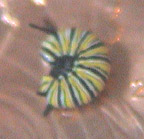|
Click
on a picture for a close-up view.
|
|
|
|
|
|
Picture #1
|
Picture #2
|
Picture #3
|
Picture #4
|
We tried
to interview your caterpillar about its feelings on wasps Picture
#1 but it was still to painful to talk about and your caterpillar
walked away from the microphone <look closely and you will
see it walking away picture #2>. We believe it had heard
the stories from others of unprotected caterpillars being taken
from their leaves and friends, never to be seen again. It is
at about this age that the caterpillar gets very cautious about
its surroundings and will actually signal others if danger is
present. A flick of its head and possibly a low pitch tone is
repeatedly made to warn its friends who may curl up into a defensive
position. Your caterpillar curled up when we took its picture
below.
Your caterpillar
was back eating within a minute or so and kept very focused
on that task for the rest of the day stopping only when full
to hold on to the mesh wall of its protective enclosure and
rest. Often a caterpillar will rest with its head down. This
resting is usually in preparation for something strenuous and
you should never bother a resting caterpillar. After a few hours
it did do something interesting! It used silk threads which
it created from its mouth to glue its tail to the fabric wall.
Your caterpillar often uses its silk to attach a life line to
wherever it is going as a safety cord. You can easily see these
fine threads all over the enclosure if you look closely. Once
it was securely attached it pulled itself forward and slipped
right out of its skin. It does this in order to be able to grow
bigger, you remember "molting". This is instar #3 and you can see the slight color changes
taking place, Picture #3.
At this
stage you can often find small caterpillars on different parts
of the milkweed plant at different times of the day, in the
morning they are down low, in the afternoon they venture into
the top leaves. It may know when wasps are likely to be flying or have an internal clock? The soft horns on its head and tail are getting
bigger.
Now is a
Very good time to think about getting some small plants so you
will be ready to raise a caterpillar at your home when this
online program ends. Taking the time to learn
about exactly how to care for our Monarch friends is so important and will help you keep all your butterflies very happy and safe. A caterpillar this size will consume
several small tender leaves a day! Please have extra milkweed
growing in case of unforeseen events. A few nice milkweed plants
in a yard will catch the eye of a female Monarch and eggs will
be laid. We can not stress the importance of having plenty of milkweed growing, one female can lay hundreds of eggs and that means lots of milkweed.
The live
Monarch Foundation is happy to bring you this free learning
experience and hope you will share your, lessons with others
and help Butterflies in your area by planting seeds for their
caterpillar children. Please take advantage of our Free
Seed Program and please tell others about this online pet
adventure!
Next update
in 3 days.
How Big
is my Caterpillar?  These pictures use a penny as a size comparison.
These pictures use a penny as a size comparison.
|

